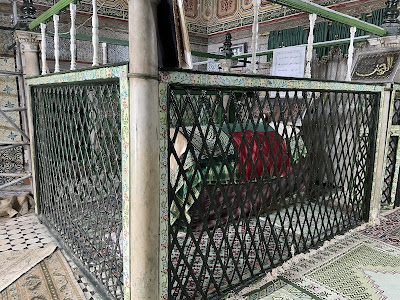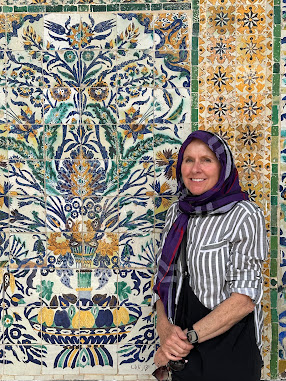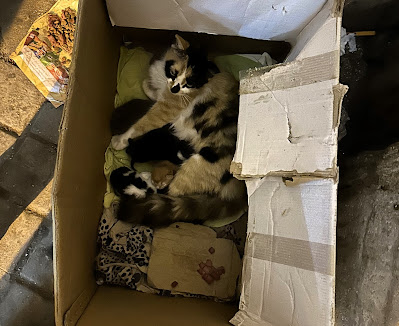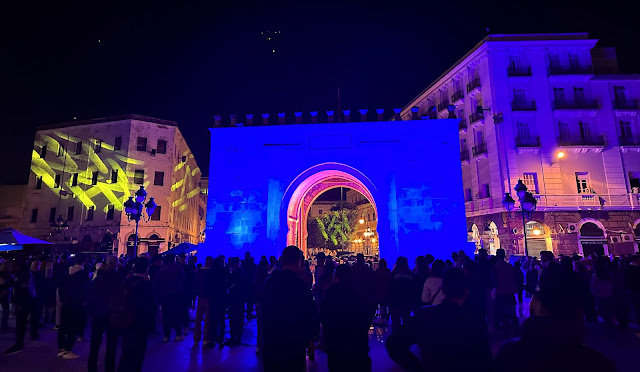March 21, 2024
As we walked deeper into the old town section of Kairouan, we came to the Mausoleum of Sidi Abid Al-Ghariani.
This building was built as a madrasa (school for studying the Quran) in the 14th century by a Kairawani scholar known as Al-Jadidi. After he died while on a pilgrimage to Mecca in 1384 AD, his disciple Sidi Abid Al-Ghariani carried on his work. When Sidi Abid died in 1402 AD, he was buried here, and ever since the school has borne his name.
It is a spectacular example of the local architectural style.
Check out this amazing craftsmanship:
I think this must be the tomb, but we were not allowed to go into the room itself and this photo was taken from the door.
Quite the photo backdrop, right?
Back in the car, we learned that our guide Feker had another profession as a wedding singer. Bob asked him for a sample solo, and it turned into a bit of a scary jaunt as he sang and drove at high speeds down the road.
A Zawiya is a building associated with the branch of Islam called Sufiism.
The mosaic carvings and stone carvings are some of the most beautiful we saw in Tunisia.
Down we went into the dungeon.
Back outside, Chris and I decided to climb up into the seating for a better view.
Meanwhile, our men were checking out the view on their cell phones.
There were a lot of people walking on the promenade, talking and laughing, and in general enjoying the cooler night air. It felt safe and welcoming to us. We passed by the St. Vincent de Paul Cathedral, the only Catholic cathedral in the Muslim country. The figure in front of the church is a statue of Ibn Khaldun, one of the greatest Arab social scientists of the Middle Ages and considered to be the father of historiography, sociology, economics, and demography studies.
But . . . next to Ibn Khaldun was an army jeep and a bunch of men in uniform holding really big guns. There had been some demonstrations or attacks or something in the last few months, and the army was on hand to "keep the peace." Okay, suddenly we didn't feel quite as safe and welcome.
Well, it had been a long day, and we were tired and ready for bed. However, this is what was happening in Victory Square right in front of our hotel:
I believe this is a place to remove your shoes before going into the prayer room . . .
. . . which we could not enter, but we could take this photo from the doorway.
We got back on the road, where as usual we saw lots of things we don't see at home.
Nike filmed a commercial here in 1996:
The tomb:
We got back on the road, where as usual we saw lots of things we don't see at home.
Our next stop turned out to be one of our favorite places in Tunisia, the Amphitheater of El Jem, a UNESCO World Heritage Site.
A camel was parked outside, like a taxi waiting for riders.
It even had a hood ornament, although this looks pretty awful.
The El Jem amphitheater, one of the biggest in the world, was built around 238 AD and is one of the best preserved Roman stone ruins in the world. The Roman Colosseum was built in 70-80 AD, so El Jem expanded on the technology, physics, and architecture of that earlier building. The Colosseum measures 620' x 511' while this amphitheater measures 485' x 400', and the Colosseum could seat 65,000 while El Jem Amphitheater could seat 35,000 (still a huge number), so El Jem is not as large, but it seemed to us to be much more intricate, and it had the huge advantage over the Colosseum of being almost empty of other tourists when we were there!
Nike filmed a commercial here in 1996:
The 2000 movie Gladiator was also filmed here.
The Romans built at least 230 amphitheaters around the world. (Amphitheaters have 360-degree seating as opposed to semicircular theaters, which are more common.) Most of them are in very poor condition, so we were surprised we had never heard of this one, which was in exceptional condition.
Axis and Allied forces (including Americans) fought in Tunisia from November 1942 to May 1943. They left their mark, literally, on the place.
There is a holding tank beneath the main floor for lions and wolves and prisoners.
Down we went into the dungeon.
It was time to start the long drive back to Tunis. We passed through the farmers market on our way to the car and were impressed by the quantity and quality of the produce in this arid area of the world.
So many dates!
I don't recall ever having seen them hanging in bunches like this:
This picture was taken through the car window, but again, you the variety of fresh produce available is impressive.
Feker's cousin wanted to stop at a "candy store" to get some treats for his kids. We certainly weren't going to disagree! It's interesting to see all the European and American chocolate names: Kinder, Milka, Nutella, Côte d'Or, Snickers, and Twix.
It was an impressive array of chocolate. Nutella seems to be very popular.
After dropping off Feker's cousin, we had our iftar meal at a restaurant not too far from our hotel. Again we admired the diners waiting patiently for sundown before digging into their food. My meal was a little less spicy than what I'd had the previous night. I had brik again--the stuffed pastry shell I had enjoyed the previous evening, followed by a chunk of overcooked lamb and a few veggies piled on top of a mountainous heap of couscous.
After dinner we spent a while learning about the Arab Spring Revolution from Feker. I have always associated the 2011 uprising with Egypt. I remembered seeing the results of Arab Spring when we visited Cairo in 2015. However, the uprising actually began in Tunisia as demonstrations against government corruption and economic stagnation, and then spread to five other Arab countries, including Egypt, from there. It was interesting to hear about Arab Spring from Feker's perspective and his mixed feelings about the future of democracy in Tunisia. He is well-educated and pro-democracy. And while a very devout Muslim, he did not take a hardline approach with us. He was a great find as a tour guide.
We walked with Feker back to our hotel along this promenade that lay between the two busy lanes of traffic on Avenue Habib Bourguiba. When the promenade finishes and the two streets come together, they make the Avenue de France, the street that dead-ends into Victory Square, which lies in front of our hotel, the Royal Victoria. This is looking down the promenade away from our hotel.
I asked Siri about how safe we were, and that didn't help either.
Nevertheless, I wanted a photo! I did my best to be sneaky, and this was the best I could do.
Just beyond the military presence was this ubiquitous photo spot, inaccessible to Instagram photo seekers because of barricades.
And beyond the military and the I 💓 Tunis sign was the Porte de France, or French gate, and beyond that, our hotel.
It was still relatively early, so we decided to take a peek into the medina, or old shopping center. We were planning on spending more time there the next day, but the evening vibe was enticing.
A UNESCO World Heritage Site, this cobweb of pedestrian streets and narrow alleys has about 700 palaces, mosques, madrasas, fountains, mausoleums, and other monuments, some of which date back to the 12th century.
Many of the shops feel decidedly more modern than that.
The Madrasa Palmier (left) was built in 1714 and still functions as a Quranic school. It is not open to the public. On the right is the door to a bathhouse, signified by what we would think of as a striped barber pole.
We stopped for a look into this beautiful room that now serves as an art gallery.
Then we had what was basically an essential oils demonstration where we learned how their scented oils are made. I was particularly interested in the orange blossom oil because we had learned that they often grow orange trees with the intent to harvest their sweetly scented blossoms rather than their fruit. Since the scent of orange blossoms in my favorite, I of course bought a couple of bottles and convinced Chris to buy some too.
There was a long line at a dessert stall, and Feker encouraged us to try the local delicacy. It was kind of like frozen yogurt, and we could choose our toppings. I'd give it an A+.
We noticed quite a few cats in the medina--I'm sure they keep the mice and rat population down--and we had to stop to admire this mother cat with a litter of kittens in an old cardboard box.
Unfortunately, we didn't get a lot of sleep because this party went on until at least midnight--amplified drum beats, dancers, light shows, and hundreds of noisy people. CRAZY.
But hey, we don't travel to be comfortable or get a good night's rest, right? We travel to experience other cultures and see things we haven't seen before! This party definitely fit the bill.








































































I was a little disappointed overall in Tunisia. I was expecting more. For the fourth most holy place in Islam, Kairouan was not that impressive, particularly when compared to Amman and Istanbul. But the one thing that was more impressive than I expected was El Jem. It felt more impressive to me than the Colosseum, probably because we had free reign. We weren't confined to tourist areas only, but could roam all over the place, up into the stands and down below ground. That Nike commercial is really fun. I also didn't feel that the souk was that great, compared to Istanbul or Fez or Marrakesh, except for the seafood market you'll be blogging on later that I think is the best one we've ever visited. I also felt like the food we had was so-so.
ReplyDelete